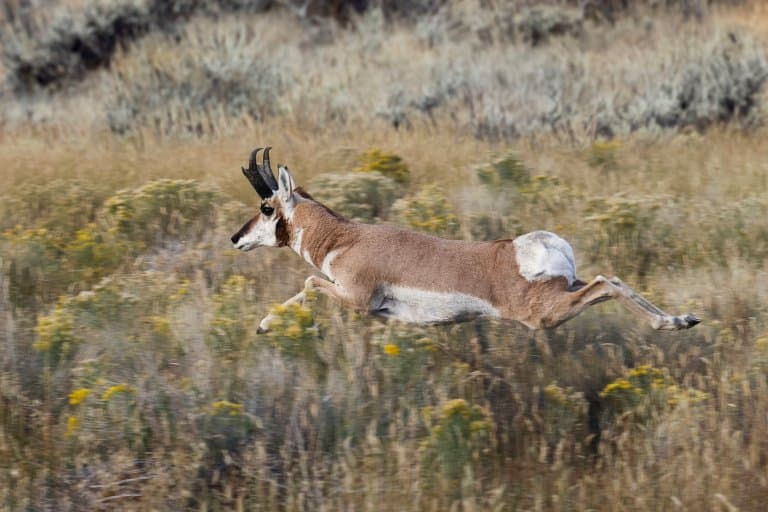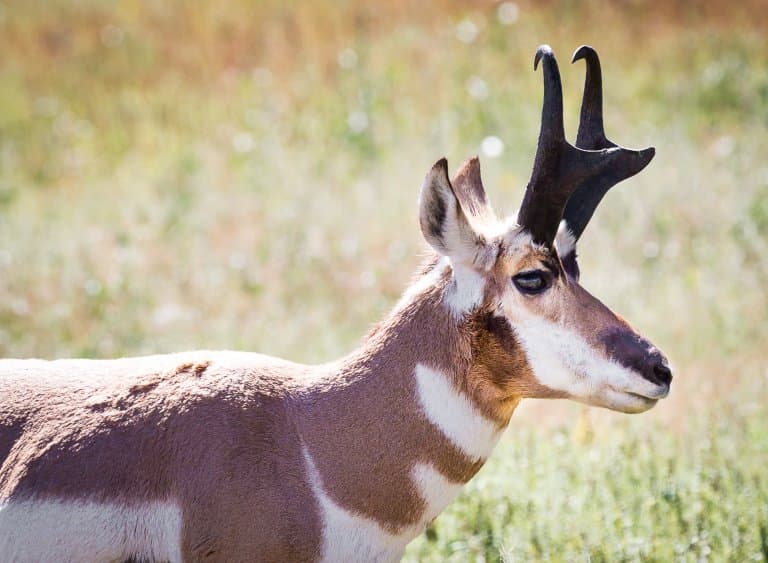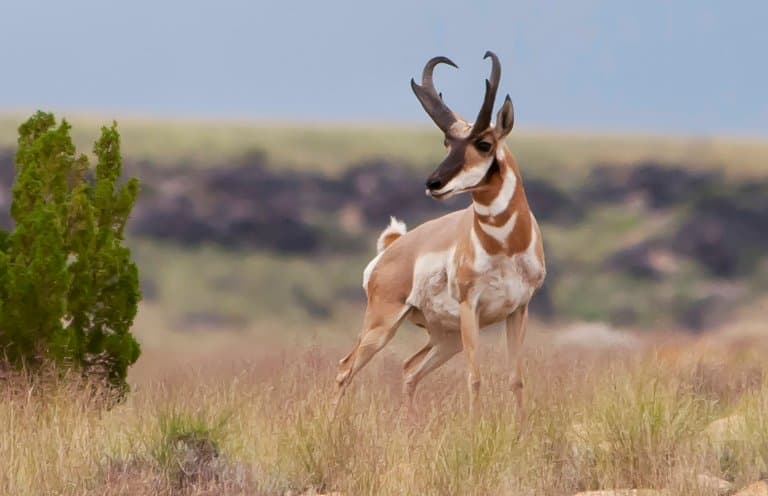Pronghorn Profile
Predators tend to leave an impression on their prey, whether it’s in the flesh of those they kill, or in the DNA of those they miss. The pronghorn is an example of the latter.
Its adaptations were honed through generations of biological trial and error; the survivors holding onto solutions to a problem long since removed.

Pronghorn Facts Overview
| Habitat: | Open plains |
| Location: | US and Canada |
| Lifespan: | 12-14 years |
| Size: | 1.3 – 1.5 m (4ft 3 – 4ft 11) length, 80 – 105 cm (2ft 8 – 3ft 5) in height |
| Weight: | 65kg / 183 lb |
| Color: | Golden brown with white belly and rump |
| Diet: | Forbs and shrubs |
| Predators: | Cougars, wolves, coyotes, grizzlies |
| Top Speed: | 100 kph (62 mph) |
| No. of Species: |
1 |
| Conservation Status: |
Least Concern |
Pronghorns look a lot like antelopes, but their lineage is quite different. That doesn’t stop them from being referred to as the American antelope, pronghorn antelope or prairie antelope though. Still, they’re well adapted to escape many of the same predators, yet none seem to exist where they live.
Pronghorns inhabit open plains and often high elevations across the US, Canada and Mexico. They are most active at dawn and dusk, and spend their time dieting on shrubs, grasses, cacti and other vegetation.
There are 4 subspecies, that include the Sonoran pronghorn, the the Mexican pronghorn, the Oregon pronghorn, and the Baja California pronghorn.
Pronghorns form mixed social herds in the winter of up to 1,000 individuals, which break up into younger male and female groups in the spring. Adult males live solitarily, and are territorial – leaving their scent, vocalizing and challenging male intruders. They will fight for dominance and mating rights with females.
Once hunted almost to extinction, they have made a startling recovery, and though still stifled by human land use, they’re holding out well in the plains of North America.
Interesting Pronghorn Facts
1. They’re not what they appear to be
Classically, the interlopers to the new world referred to the pronghorn as an antelope. And it does rather look like one, as well as filling a very similar niche to the African ungulate of the same name.
However, its closest African relatives are the giraffe and okapi, and it is the only remaining species within its family.
11 other species used to live with it in North America, but then humans arrived, and we all know what happens when they do that.
The pronghorn, probably because of its outstanding sportiness, is the only one left.
2. They’re the fastest land animal in the West
Sporty might be a bit of an understatement. Not only can this animal run long distances, but it may also be one of the fastest runners in the Western hemisphere.
Sustained speeds of up to 65 kmph have been reliably recorded, and busts of up to over 90kmph are thrown around recklessly on the internet.
While they might be second behind the cheetah in outright speed, the pronghorn can sustain it over a longer distance, and is capable of running 65kmph (40mph) for at least 11km (7 miles).
They’re able to achieve these feats with either extremely efficient musculature, or incredibly effective respiratory transport systems, or both. They have enormous lungs, and hearts four times that of a sheep. 1

3. Their name is from the shape of their horns
Each horn on the head of male pronghorns has a long point that turns at the end, and has a forward pointing ‘prong’ or fork coming off each side of it.
Their horns are really a cross between horns and antlers and are composed of bone thought to grow from their skull, which shed each year. This makes them unique, as the only amimal in the world with forked horns that shed.
Female pronghorns generally have shorter horns that don’t have the same prongs.

4. They have 13 gaits!
Humans move in a number of ways. There’s the plod, the shuffle, the waddle and that awkward performance of a person trying to avoid getting in the way of someone else’s photograph. Our natural gaits, however, can be categorised as either a walk, jog, skip, run or sprint. That’s five.
Horses walk, trot, canter, gallop, and in some cases tölt and pace. That’s six, but ultimately, these two easily startled herd animals have nothing compared with the glamour and diversity of the pronghorn.
Not only can they change between gaits fluidly, they have thirteen of them. And that’s a single count based on one study in Canada. There’s still a lot to discover about how well these animals can move.
But the reason for their amazing abilities seems clear. 2
5. Pronghorns migrate
An study from the Lava Lake Institute for Science and Conservation and the Wildlife Conservation Society has shown that pronghorn migrate more than 260km (160m) from Idaho to the Continental Divide each year in the US.
While common in Africa, this is a rare phenomenon in the US.

6. They are reflections of an extinct predator
This exceptional locomotion comes as a response to a distant predatory past.
Evolution doesn’t kick out superheroes for the sake of it; resources are only spent where they’re absolutely needed, and the pronghorn evolved to respond to a much higher class of predator than anything alive in its environment today.
Essentially, all of these adaptations came from having to escape something even faster and more agile than it is, and while whatever that was has long since gone extinct, the winner of this evolutionary arms race retains all the characteristics that allowed it to reach this point.
Up until around ten thousand years ago, there were lions and cheetahs in North America. It’s likely this was one of the selective pressures that made the pronghorn so fast.
It has eyes far larger than average for an animal of its size, able to spot movement from four miles away. It has a wide-angle view of the world, and the aforementioned speed and endurance that allow it to quickly spot and outpace its current threats.
At least, if it even reaches adulthood. 3
7. Coyotes are now their major threat
Nothing much will waste its time chasing an adult pronghorn, but the young are still vulnerable to predation. Coyotes remain the primary threat, but a bear will have a go too.
Even as precocious as they are – pronghorn fawns can stand within about 20 minutes of touching the ground – an animal as intelligent as a coyote finds ways to hunt them.
Pronghorn mothers will hide their fawns in small divots or taller brush. They’ll then forage a substantial distance away to give no sign of where the baby is kept.
Coyotes spotted looking for a fawn will be met with the hooves of a disgruntled mother, so instead, they’ve learned to play dumb. They make out to be minding their own business, hunting mice or other small game, and if they’re able to spot a fawn in doing so, they’ll wait until the mother isn’t looking before they snatch it.
This threat leads to only 13% of fawns making it past their first year, this rate is attributed primarily to the predation from coyotes.

8. Pronghorn rarely sleep
While they do rest as a heard, it’s not often they close their eyes and actually sleep. They stay on alert for predators instead.
When they do sleep, it will be for no more than 10 minutes at a time, while others in the herd are on watch for potential predators.
9. They’re making an incredible comeback
While the pronghorn may have no natural match when it comes to predation, they’re not faster than a bullet. Hunters reduced populations down to what appeared to be unsustainable numbers until protections were put in place during the ‘30s.
Since then, there may be more than one million individuals who have returned to their old pronking grounds, a remarkable recovery.
As usual, habitat fragmentation remains an issue, and migration corridors are not as available as they should be, but the numbers of pronghorn now exceed that of people in Wyoming, and no universal threat is currently present, so they’re doing ok.
10. The Baja California pronghorm isn’t doing so well
The Baja California pronghorn is found on the Baja peninsula, which is northwestern Mexico.
The increase in human population and urbanisation has made it difficult for the Baja California pronghorn subspecies, which has limitations on its range for food and water. This has in turn, reduced it’s genetic diversity, which makes it more susceptible to disease.
Sadly there’s thought to be under 150 left, and conservation efforts are ongoing to aid recovery.
Pronghorn Fact-File Summary
Scientific Classification
| Kingdom: | Animalia |
| Phylum: | Chordata |
| Class: | Mammalia |
| Order: | Artiodactyla |
| Family: | Antilocapridae |
| Genus: | Antilocapra |
| Species Name: |
Antilocapra Americana |
Fact Sources & References
- Stan L. Lindstedt (1991), “Running energetics in the pronghorn antelope“, Nature.com.
- Alex Hawes (2001), “PronghornsSurvivors of the American Savanna“, Zoogoer.
- John A. Byers (1998), “American Pronghorn: Social Adaptations and the Ghosts of Predators Past“, University of Chicago Press.
